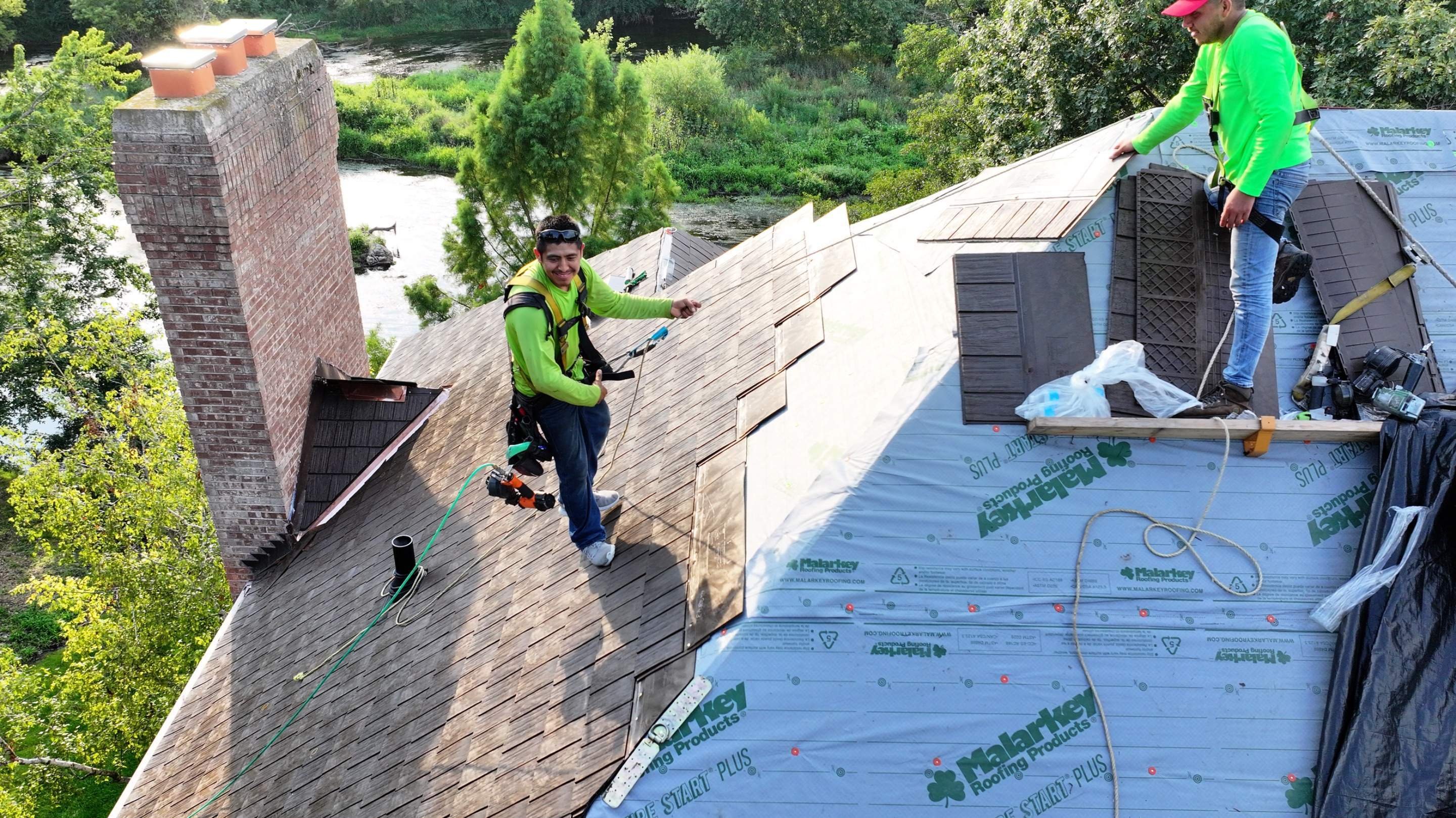What Impacts the Cost of a Roof Replacement? Top Pricing Factors

Getting a new roof is a major investment; if you’ve already started collecting quotes, you might be surprised by how different the prices can be. Not all roofing estimates are built the same, and it’s not always easy to spot where these differences lie. So what’s really driving those numbers?
While the size of your roof plays a role, there’s much more at work behind the scenes, from the materials you choose to the shape and steepness of your home, and even how easy it is to get equipment in place. At Happy Roofing, we’ve spent years helping homeowners understand what goes into a quality roof and an honest estimate. As a licensed, certified, and locally trusted roofing contractor, we believe transparency is the most crucial part of the roof replacement process.
In this article, we’ll break down the key factors that influence the cost of a roof replacement, so you can feel confident in understanding what you’re paying for and why.
Table of Contents
- Factors That Influence Roof Replacement Costs
- How to Ensure You Are Understanding Your Roofing Quote
What Factors Influence the Cost of a Roof Replacement?
Roof replacement costs can vary widely depending on a mix of structural, material, and project-specific details. Here are some of the most common factors that often affect pricing.
Roof Design and Complexity
It’s not a far-fetched assumption that the more complex the roof, the more labor-intensive the job becomes. Complexity isn’t just about how big your roof is, but how difficult it is to work on, and all of these factors can directly influence cost:
- Pitch/Steepness: Steeper roofs often require specialized safety gear and extra crew coordination. Installers must move more slowly, more cautiously, and employ different techniques, which increases labor time.
- Multiple Valleys, Levels, or Facets: Roofs with lots of angles, intersecting planes, or multi-level designs take longer to measure, cut, and install materials correctly. The more cuts and seams, the more chances for errors, leaks, and waste if the crew does not take extra care.
- Skylights, Chimneys, and Dormers: Each penetration in the roof adds to the complexity. These areas require flashing to prevent leaks and sometimes need to be replaced for a long-lasting, warranty-backed installation.
- Height and Accessibility: Tall homes, steep driveways, and limited yard spaces are harder to access with ladders, scaffolding, and material lifts. This can slow down work and clean-up; it may even require specialized equipment, especially in tight spaces.
- Material Handling, and Cleanup: Complex roofs tend to generate more waste and often involve extra steps to stage materials safely. This is especially true when storage space on-site is limited. Labor crews may also need to carry materials by hand to and from hard-to-reach sections, increasing costs.
Layers and Tear-Off
If your existing roof has multiple layers of shingles, all of them will need to be removed before new materials can be properly installed. This process, known as a tear-off, involves added labor, disposal logistics, and sometimes uncovering hidden issues beneath the surface. Let’s break down what can influence cost differences:
- Labor & Disposal: Sometimes it’s hard to tell exactly how many shingle layers a roof has until tear-off has begun. Each additional layer takes more time to remove and adds additional labor and weight to be hauled away. If it applies to your home, your contractor should consider this before providing an estimate.
- Hidden Issues: Whether the roof is multi-layered or not, shingles can hide problems like rotted decking or moisture damage. While there can be signs initially, the extent of these issues can’t fully be verified until the old roofing has been stripped off and may lead to additional repair costs.
Every situation is unique, which is why a thorough initial inspection is crucial. Because of its ability to drastically alter final costs, a good contractor will consider all removal and cleanup costs before providing an estimate.
Roofing Material Choice
The materials you choose for your roof have a major impact on both cost and long-term performance. Here’s a breakdown of popular roofing types and what they offer:
| Roofing Material | Description |
| Asphalt Shingles | The most common roof material type in Illinois. Affordable, easy to install, and widely available. Comes in 3-tab, architectural, and designer styles. |
| Cedar Shake/Shingles (Natural Wood) | Made from split cedar wood, it offers a rustic and natural appearance. Needs to be maintained often to preserve durability and appearance. |
| Synthetic Materials (EuroShield/DaVinci) | Synthetic roofing that mimics natural slate or cedar shake, at a premium price point. There are also eco-friendly options made from recycled rubber. |
| Metal Roofing | Modern, long-lasting roofing made from metal panels or stamped shingles. |
It’s common for many homeowners to focus on the shingle brand, but it’s just as important to consider the full roofing system; every component works together to protect your home. If you'd like to learn more about what a roofing system consists of, as well as why every piece matters, read our article: What is a Roofing System? (And Why Every Component Matters).
Manufacturers often offer better warranties when all components come from the same brand. Some contractors may list a premium shingle but cut corners with cheaper accessories to lower their bid. If it’s unclear, ask to see the full list of materials included in your quote, and verify that all items align with the primary brand. You want curb appeal and longevity.
Repairs and Variable Charges
Even the best roofing quote can’t account for every possible issue hidden beneath the surface. Once your old roof is removed, additional repairs may become necessary, and those repairs can quickly influence the final cost.
Roof Decking Condition
Roof decking refers to the wood beneath the shingles, and it needs to be solid to properly support the new system. Warped, rotted, or otherwise damaged pieces should be replaced at the time of roof replacement. Unfortunately, rotted or damaged decking is hard to completely assess before removing any shingles.
You should be made aware of the possibility ahead of time, and your quote should include a line item cost per sheet of plywood if your roof needs any of the existing material replaced. Below is an example of how we include this variable line item in our roofing quotes:

Ventilation Upgrades
Poor attic ventilation is one of the most common issues discovered during roof replacement, yet one of the most frequently overlooked items in quotes. Without proper airflow, your roof system can overheat from the inside out, shortening shingle life and increasing the risk of mold, moisture damage, warped decking, and lost warranties.
A thorough inspection should evaluate your current intake and exhaust system, and include any necessary upgrades to meet code or manufacturer requirements to maintain warranty. These upgrades can vary in cost depending on your attic size, roof design, and what ventilation is already in place. Below is a graphic demonstrating how proper ventilation should work:

Labor and Craftsmanship
Not all roofing companies are created equal. The experience, training, and care taken by installers can have a major impact on the final product and cost. A highly skilled crew may come at a higher cost, but the payoff is often a roof that lasts longer, performs better, and avoids common installation issues.
Look for estimates that go beyond just listing materials. In an ideal world, they would include a detailed breakdown of installation labor. When every component and task is accounted for, it shows the contractor is focused on delivering a complete, high-quality job rather than cutting corners to offer a low price.
How To Make Sure You’re Understanding A Roofing Quote
As you’ve learned, the true cost of a roof replacement goes beyond square footage and shingle color. From your home’s architecture and accessibility to the quality of materials, many factors shape the final cost. The more informed you are about what goes into a quote, the more confident you’ll feel navigating your options, and the more likely you are to spot vague estimates.
At the end of the day, a thorough and honest estimate will clearly break things down, explain the why behind each item, and prepare you for any variables that may arise once work begins. If you're unsure how to evaluate the quotes you’ve received, or you want a clearer picture of what a good roofing estimate should look like, check out our blog: How Happy Roofing Builds an Honest Roofing Estimate: And How to Spot Red Flags. It’s designed to walk you through how a trustworthy quote is structured so that you know exactly what to look for when comparing roof replacement quotes.
If you'd rather speak with a professional directly, we offer no-commitment roof inspections to assess your unique situation. Our goal is to provide you with clear and honest guidance without pushing you into signing any paperwork or agreeing to any projects with us.
The Author: Pedro Toledano
Happy Roofing is a trusted roofing company dedicated to providing top-quality roofing services to residential and commercial clients. With years of experience, they specialize in roof installations, repairs, and maintenance, ensuring durability and customer satisfaction. The team is known for their professional approach, timely service, and attention to detail. Happy Roofing prides itself on using high-quality materials and offering competitive pricing. Follow their Facebook page for updates on projects, customer testimonials, and tips on maintaining your roof in excellent condition.





